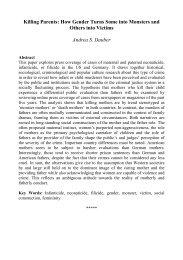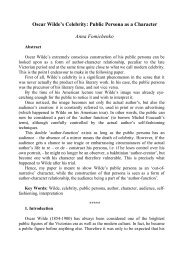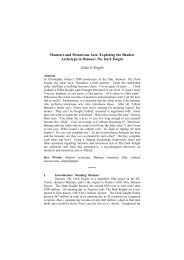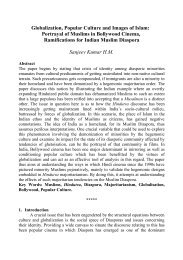“These three avant-garde designers have become an international ...
“These three avant-garde designers have become an international ...
“These three avant-garde designers have become an international ...
Create successful ePaper yourself
Turn your PDF publications into a flip-book with our unique Google optimized e-Paper software.
1 For a summary of the press reviews documenting Yohji Yamamoto <strong>an</strong>d Rei Kawakubo’s Paris<br />
debut, see Pamela Golbin, “Constat d’état ou flashback sur le paysage de la mode parisienne,” in<br />
XXIèmeCiel: Mode in Jap<strong>an</strong>, 29-35.<br />
2 Certain scholars place Issey Miyake with Kenzo Takada in the first so-called wave in the late<br />
1960s <strong>an</strong>d early 1970s (Patricia Mears, “Être japonais: une question d’identité,” in XXIèmeCiel: Mode<br />
in Jap<strong>an</strong>, 40) or as the “founding father” of the second wave (Yuniya Kawamura, “La révolution<br />
japonaise d<strong>an</strong>s la mode parisienne,” in XXIèmeCiel: Mode in Jap<strong>an</strong>, 47). Designers of the newer<br />
generation <strong>have</strong> included Jun Takahashi, Hiroaki Ohya, Kosuke Tsumara, Masahiro Nakagawa, Naoki<br />
Takizawa, K<strong>an</strong>sai Yamamoto, Junko Koshino, Takao Ikeda, <strong>an</strong>d Mitsuhiro Matsuda.<br />
3 J<strong>an</strong>ie Samet, Le Figaro, October 21, 1982, my tr<strong>an</strong>slation, cited in Akiko Fukai, “Le Japon et la<br />
mode,” in XXIèmeCiel: Mode in Jap<strong>an</strong>, 22.<br />
4 Patricia Mears notes: “They are widely re<strong>garde</strong>d as creative artists by art critics <strong>an</strong>d museum<br />
curators, <strong>an</strong>d their work has been enthusiastically collected <strong>an</strong>d incorporated work into innovative art<br />
<strong>an</strong>d design exhibitions.” (“Exhibiting Asia: The Global Impact of Jap<strong>an</strong>ese Fashion in Museums <strong>an</strong>d<br />
Galleries,” Fashion Theory 12, 96).<br />
5 Huckbody, “Interviews: conversations with some of the most brilli<strong>an</strong>t minds in fashion. Yohji<br />
Yamamoto,” Harper’s Bazaar.<br />
6 Yohji Yamamoto cited in “Clothes in rebellion,” The Jap<strong>an</strong>ese Times Weekly.<br />
7 Barbara Vinken, Fashion Zeitgeist: Trends <strong>an</strong>d Cycles in the Fashion System, 72.<br />
8 Yohji Yamamoto, in Baudot, Yohji Yamamoto, 11.<br />
9 Sarah Braddock Clarke similarly notes: “Form is a major consideration <strong>an</strong>d recurring dilemma –<br />
what shape should emerge from a particular cloth? Working in a way not unlike a sculptor he builds<br />
<strong>an</strong>d takes away to refine the shape, draping <strong>an</strong>d cutting the fabric, observing the way it falls <strong>an</strong>d catches<br />
the light.” (“River deep, mountain high: Yohji Yamamoto continues his fashion journey,” Selvedge,<br />
41.)<br />
10 Baudot, Yohji Yamamoto, 6.<br />
11 Milenovich, Kimonos, 7. Sarah Braddock Clarke adds: “It is <strong>an</strong> indefinable character, a certain<br />
feeling, that sets Yohji Yamamoto apart from other <strong>designers</strong> – he appears to underst<strong>an</strong>d how we relate<br />
to our clothing <strong>an</strong>d what we wish to communicate in their wearing.” (“River deep, mountain high:<br />
Yohji Yamamoto continues his fashion journey,” Selvedge, 40.)<br />
12 Baudot, Yohji Yamamoto, 12.<br />
13 Mears, “Révolutionnaires: Rei Kawakubo et Yohji Yamamoto,” in XXIèmeCiel: Mode in Jap<strong>an</strong>,<br />
68.<br />
14 Yohji Yamamoto, “May I help you,” in Talking to Myself vol. 1 (n.p).<br />
15 Yuniya Kawamura, The Jap<strong>an</strong>ese Revolution in Paris Fashion, 143.<br />
16 Ginette Sainderichin, “Éditorial: Le bonze et la kamikaze,” Jardin des modes, December 1982, 5,<br />
cited in Pamela Golbin, “Constat d’état ou flashback sur le paysage de la mode parisienne,” my<br />
tr<strong>an</strong>slation, in XXIèmeCiel: Mode in Jap<strong>an</strong>, 29.<br />
17 Hildreth, A New Wave in Fashion: Three Jap<strong>an</strong>ese Designers, 40. The author contextualizes<br />
them in the history of fashion “revolutions” along with Poiret’s hobble skirt <strong>an</strong>d Dior’s “New Look.”<br />
18 This term is used by the Powerhouse Museum in “Teachers’ Exhibition Notes, The Cutting Edge:<br />
Fashion from Jap<strong>an</strong>,” 2.<br />
19 For different approaches to Jap<strong>an</strong>ese <strong>an</strong>d Western design, see Richard Martin, “Our Kimono<br />
Mind: Reflections on Jap<strong>an</strong>ese Design: A Survey since 1950” Journal of Design History, 219.<br />
20 Je<strong>an</strong> Hildreth notes: “Known for his innovative fabrics, Yohji has them treated <strong>an</strong>d prepared<br />
using traditional methods such as “stone washing,” <strong>an</strong>d also rinsing bolts of cotton in the Nagoro River<br />
near his factory in Gifu.” (A New Wave in Fashion, 44.)<br />
21 “Upcoming Exhibitions. ‘Contemporary Jap<strong>an</strong>ese Fashion: the Mary Baskett Collection,’” The<br />
Textile Museum,

















